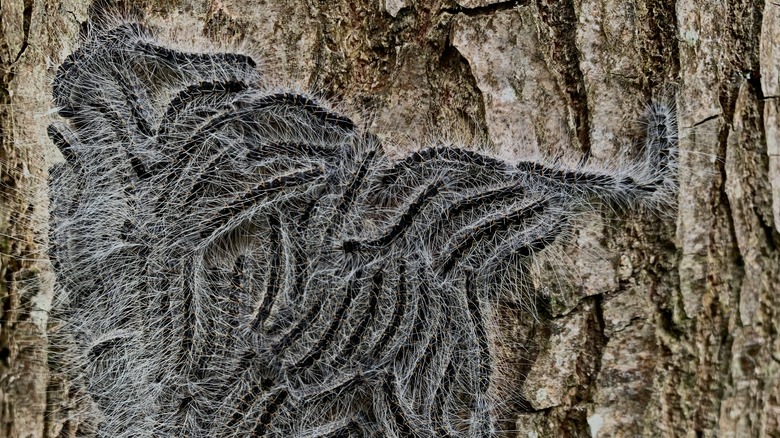Here's What It Means If You See A Black Bag In A Tree
If you live in parts of central and southern Europe, you may have walking around outside and stumbled across a tree that has a mysterious black bag waving from its branches. No, this isn't a piece of litter that got blown away — in fact, it's a good sign that you should be steering clear of the tree in question. These black bags are actually used to control trees that are infected with poisonous oak processionary caterpillars.
Though these fuzzy caterpillars may look cute and harmless, they're actually one of many pesky poisonous caterpillars to watch out for in your garden; each hair on their bodies actually contains a toxin that can pose risks to your skin. Maybe you've noticed defoliation on your backyard oak trees; oak processionary caterpillars also harm the oaks they take up residence in, eating away at the tree's leaves until it struggles to sustain itself (and defend against other pests and diseases).
The black bag method is just another eco-friendly way to deter pests. It's designed to help trees under attack from oak processionary caterpillars without exposing the area to pesticides. Instead, the bag is filled with pheromones that attract the caterpillars to crawl inside. Once in the bag, the small entrance causes them to be unable to find their way out. Since the bag is black, it heats up significantly throughout the course of the day, causing the caterpillars to suffocate inside.
Why are oak processionary caterpillars so dangerous to humans?
Oak processionary caterpillars have a special defense mechanism: their hair. Each hair on these grey caterpillars is ridged with tiny barbs, designed to help the hair penetrate deep into your skin. The hair contains a toxin called thaumetopoein, which can cause skin irritation, rashes, and inflammatory reactions. Your best bet is to wash your hands and clothes carefully after being nearby an infected area, and always remove any hairs that are on or in your skin.
Unfortunately, oak processionary caterpillars pose a risk even if you don't touch them. The hairs on each caterpillar can actually come loose from their bodies, and since the hairs are so light and small, they simply float away on the wind. This means that even being in close proximity to a tree infested with oak processionary caterpillars could irritate your skin if you accidentally come in contact with a caterpillar hair.
Even worse, in some cases, people have been known to inhale the small barbed hairs or get them in their eyes. The latter can cause infection, so be sure to see a doctor if you have eye irritation that isn't going away. If you inhale an oak processionary hair, you may experience cold symptoms — seek medical care if your symptoms don't go away or if they get worse. And while these caterpillars are only a danger if you live within its territory of predominantly central and southern Europe, they remain a threat to one's safety. If you do see a tree with black bags on it, it's best to stay far away from it.

